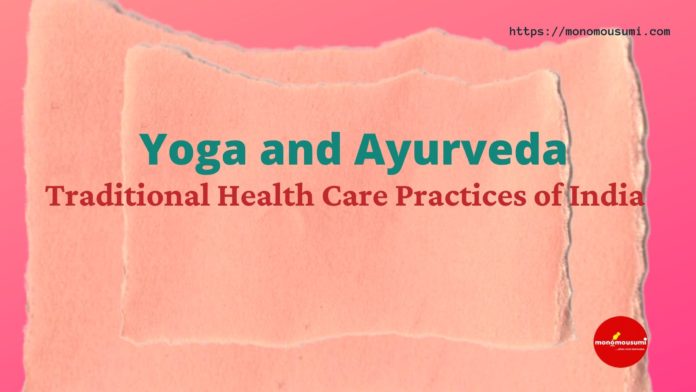The ancient sages like Patanjali, Charak, Sushruth worked and studied over for years together like the modern scientists to come up with some amazing techniques to prevent and cure the health related problems of the human kind. Those were the days when no information technology connected the places, humankind had yet to find out their way of living, people used to die of many unknown diseases like the plants and animals do. Such great and knowledgeable were our ancestors who have made us rich with incredible treasure.
Yoga shastra was a scientific treatise written by sage Patanjali in which Yoga stood for a unifying factor of body, mind and consciousness. One may also find mention of yoga in other texts even like Mahabharata, Yog Vasishth (Ramayana – teachings by sage Vasishth to lord Rama), etc. Today individuals think Yoga as a mere college of some different exercises (asanas) but as one goes into the depth one comes to know that he/she is following just the 1/8th part of this great philosophy. Yoga is made up of 8 parts called Ashtanga Yoga. They are Yam, Niyam, Asana, Pranayam, Pratyahar, Dharna, Dhyana, Samadhi. They contain the dos and don’ts of Yoga and step by step takes us to that ultimate state where body, mind and consciousness becomes one and may result in miracles.
Similarly, Ayurveda if we go on to talk about it is beyond the limits and scope of our mind. But it is based on the principle of 5 basic elements (Panchmahabhutas), 3 Tattvas that are decided by our food habits and 3 prakritis (nature) that must decide our nutritional habits. This is a part of knowledge that every human must be aware of, besides the Ayurvedacharya or Ayurveda expert practitioner. Because, If we know our prakriti it becomes easier for us to decide which type of diet must be followed by us. It gets interesting as one goes into little depth.
Everyone generally knows about the panchamahabhutas. Let us see in a bit detail about the 3 Tattvas and 3 prakritis (nature). 3 Tattvas are Tamsic, Rajasic and Saatvic. Tamasic stands for laziness, anger, etc emotions; Rajasic for restless state of mind; Saatvic stands for stable state of mind. These all are outputs of some or the other food habits. Similarly, 3 prakruthi that is Pitta, Kapha, Vata tells us what food habits suit which prakruti in which seasons (temporal aspect). It also lets us know about the diseases that each prakruti harbours and what measures and controls must be followed to prevent ourselves from them. In short, one can prepare one’s own diet plan or nutrition chart once he/she comes to know about their own prakruti. Also Ayurveda asks ones to include all the six different tastes in our balanced diet, even the bitter as it kills the germs.
Both Yoga and Ayurveda have the same Vedic roots, work on the same principle and have the same goal. They walk hand in hand. One can’t be complete without the other. The main aim is to bring body, mind and soul in perfect harmony and make one lead a healthier, happier and balanced life. Also they are not just the disease curers rather best preventers and form a robust defence system together. In the rat race that we are all a part of, somewhere it becomes necessary to find time to prevent us from falling into the traps of stress, depression, anxiety, in extreme cases suicidal tendencies,etc. Also, in the times of such pandemics, where isolations, lockdowns, loneliness, fear of uncertainty, etc. are part and parcel of life, there comes lifelines like Yoga and Ayurveda as saviour. People have even shared their experiences of benefits from breath workshops that they took part in online in their quarantine times. Hence, it wouldn’t be boasting off to say that, ‘Little Yoga a Day, keeps the doctor away’.
Our Prime Minister declared the longest day of the year as The World Yoga Day, that is 21st June to make us and the world realise our worth, contribution and cultural heritage. Also the steps of Surya Namaskaras are sculpted on the Delhi Airport representing India’s pride. “Yoga should become our everyday habit like everyday brushing of teeth or bathing.” says His Holiness Sri Sri Ravi Shankar. Let us talk about how Yoga impacts in our personal life. It doesn’t interfere with anyone’s faith or religion. Called the science of well-being, it increases intuitive ability needed by a businessman, helps students to concentrate, increases memorization capacity, brings focus and relaxation at the same time increasing our stamina for work, etc and innumerous such benefits.
In our country, we have accepted many medicinal systems and we call it traditional AYUSH (Ayurveda, Yoga and Naturopathy, Unani, Siddha, Homeopathy) plus Modern Allopathy. There is a continuous contention and prejudices related to which one is better over the others. But just like no person can’t be perfect, the systems created by him also can’t be flawless. When it comes to emergencies, everyone runs to Modern medicines; But for long term effect, to avoid side-effects, to get complete cure of long lasting disorders people do prefer traditional types of medicinal systems. It is all a matter of one’s own choice. But we must always understand that all the medicine systems are not competitive but complementary in nature and hence we must take the best of all as the ultimate goal is in saving the life rather than proving which one is better.
All the civilizations today are products of globalisation, people believe in exchange of cultures,ideas and thoughts across the globe. When we started accepting McDonalds, Dominos from western world, they learnt from us this Yoga culture, Art of Meditation. It is found that more than Indians, US and UK have daily Yoga practitioners. They have realised its true value of calmness, self- knowledge, meditation, etc. One might feel like, what could the calmness, silence bring, it is too boring. But when one examines thoroughly, one comes to know that the source of all the creativity and innovation is the same serenity, where all your ideas become crystal clear. It is the same relaxed state of mind which Einstein tries to relate in his famous quote saying, “Creativity is Intelligence having fun.”
Already people of India have ignored this treasure for about thousands of years. All know the story of the old Granny, who searches for the spectacles that are already on hung her head everywhere in her home. Same has been the case with India too. We had been searching for effective methods of well being, which we are already rich in. Today, India is grappled with many diseases along with pandemics like anaemia, malnutrition, many lifestyle diseases (obesity, diabetes, heart related disorders,etc), many mental disorders, rare diseases (Thalassemia, Sickle Cell Anaemia,etc), hormonal diseases (PCOD, Thyroid, etc), etc. Even though not sure about the cure of all, Yoga and Ayurveda can ensure ease and bring relaxation in almost all cases.
Time and again both the immense sources of knowledge and well being have proved and earned recognition and immense researches are being made and wondered about the effects found throughout in their proofs. To conclude, It is a birth right of every human being on this planet to live a healthy, peaceful life and love and be loved by everyone and one shouldn’t be deprived of it. So it is our duty to spread the incredible treasure that we own, as knowledge is the only treasure that increases by sharing it with others. Humanism is the foundation of harmony in diversity and these two great brothers are Ayurveda and Yoga are the doors that open up to it. Let’s open them.
By Aditi Subhash Dhale

















Very nice
Very nice information
Interesting
Very good
आदिती …अतिशय सुंदर व अभ्यासपुर्ण लेख लिहिलास..त्या बद्यल तुझे कौतुक व अभिनंदन … Ayurveda & Yoga हे दोन दरवाजे आपणांस सुदृढ जिवन जगण्यास कसे उपयुक्यत होतील हे छान सांगीतलं. तसंच पंचमहाभुत,३तत्व,व कफ,पित्त,वात प्रकृती बद्यल सुंदर विवेचन .. तुला खुप खुप शुभेच्छा ….पुढिल वाटचालीसाठी